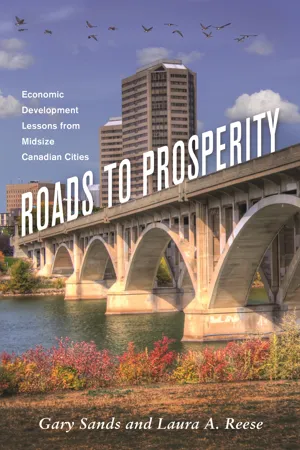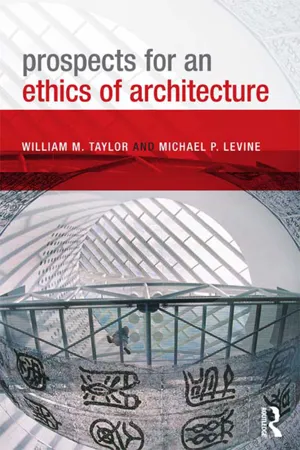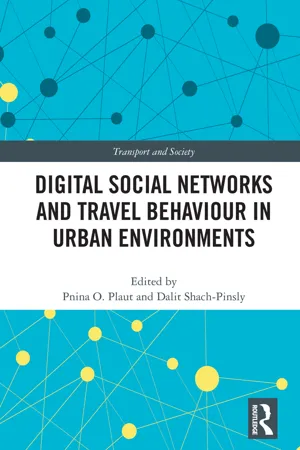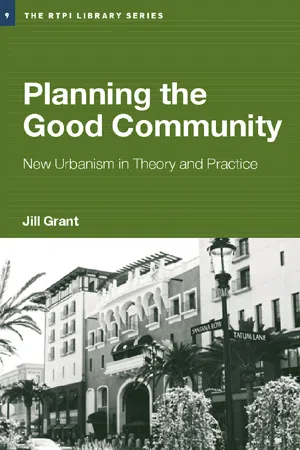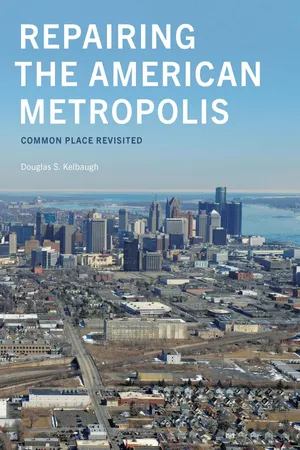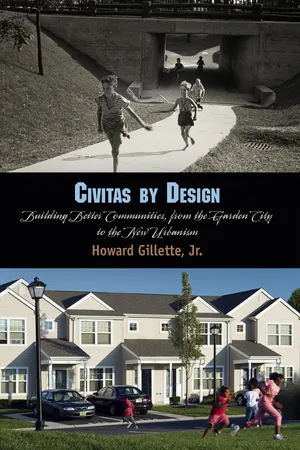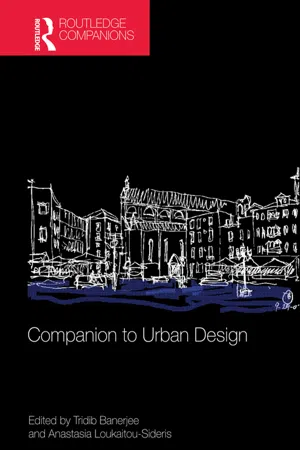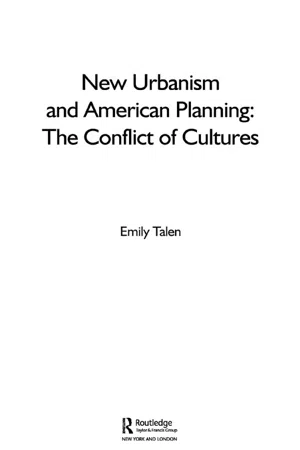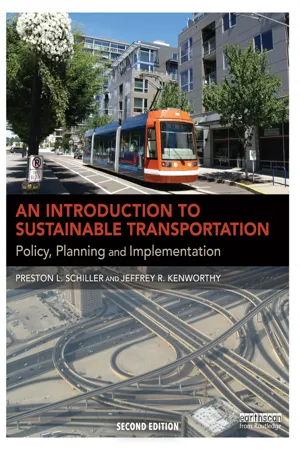Geography
New Urbanism
New Urbanism is an urban design movement that promotes walkable neighborhoods, mixed land use, and traditional architecture to create more sustainable and livable communities. It emphasizes compact, pedestrian-friendly development, with a focus on reducing car dependency and promoting public transit. New Urbanism aims to create vibrant, inclusive, and environmentally friendly urban spaces.
Written by Perlego with AI-assistance
Related key terms
10 Key excerpts on "New Urbanism"
- eBook - ePub
Roads to Prosperity
Economic Development Lessons from Midsize Canadian Cities
- Gary Sands, Laura A. Reese(Authors)
- 2017(Publication Date)
- Wayne State University Press(Publisher)
8 New UrbanismPart of a broader trend toward the restoration of community and concern for a more sustainable environment, the New Urbanism addresses many of the crucial issues of our time: the decline of America’s cities, the rebuilding of its crumbling infrastructure, housing affordability, crime, and traffic congestion.Katz, 1994C omprehensive master plans include more than just land use and circulation; they also address planning for the local economy. The primary focus of local economic development strategies has typically been on employment centers—industrial estates, office parks, and city centers. More recently, however, there has been increasing recognition that community prosperity is also a function of the quality of life offered to its residents. The suburban model of the last half of the twentieth century, while still dominant, is no longer universally accepted as the only, or the best, development paradigm. Providing alternative forms, such as densification of urban neighborhoods, transit-oriented development, and the New Urbanism, is seen as essential to attracting and retaining the growing segment of the population that rejects low density, single-use, auto-dependent, post–World War II suburban development.There are considerable similarities between New Urbanism and creative class economic development strategies. Both advocate creation of a context in which individuals and communities can flourish, rather than a direct focus on jobs or income. New Urbanism advocates more attention to the quality of urban design and physical forms that encourage interpersonal relations. Such an environment will make communities more desirable and more prosperous. - eBook - ePub
Shaping the City
Studies in History, Theory and Urban Design
- Rodolphe El-Khoury, Edwards Robbins, Rodolphe El-Khoury, Edwards Robbins(Authors)
- 2015(Publication Date)
- Routledge(Publisher)
31 New Urbanism provides a voice for those fed up with inner-city decline, the social alienation produced by conventional suburbs, and a world that seems to be increasingly dominated by the automobile. The call for towns and neighborhoods that build community suggest a regional order less dependent on the car and more amenable to pedestrian traffic; it serves as an anodyne to the prevailing planning and development practices responsible for our current plight.For many people, the apparent concern New Urbanists have with community voices and attitudes is a salutary alternative to the often dictatorial and unresponsive design strategies of many urban designers and planners of the modernist and also bureaucratic mode. In an attempt to include local visions and languages, New Urbanists often try to work with the local community in design charrettes to develop a contextual solution grounded in local circumstances and attitudes. Whether this is a marketing strategy or a genuine attempt to include locals in developing the design or a bit of both is open to question. That it is an attractive element of New Urbanist practice and ideology is not.For those developers that support the New Urbanism, it is not only an answer to sprawl and reliance on the automobile, it allows for, indeed encourages, development of sites that, previous to the New Urbanism, would have had fewer units in the same size tract. Real estate developers embrace the New Urbanism in the name of community development but, as Norman Blankman, writing in Real Estate Finance Journal, makes clear,The single most important thing that should be done to bring affordable housing within reach for millions of people is to change zoning laws to permit more compact development. The first steps have been taken by a nationwide movement [i.e. the New Urbanism] to reform US urbanism.32 - eBook - ePub
- William M. Taylor, Michael P. Levine(Authors)
- 2012(Publication Date)
- Routledge(Publisher)
On the whole, they direct attention more to the geography of urban terrain and the locations, districts and regions that make up maps – the points from which journeys (typically pedestrian) commence or to which one arrives – rather than the physically and socially heterogeneous and stratified spaces that make up the built environment. Consider the principle that ‘[1] Metropolitan regions are finite places with geographic boundaries …’ or ‘[23] Streets and squares should be safe, comfortable, and interesting to the pedestrian. Properly configured, they encourage walking and enable neighbors to know each other and protect their communities’. Commending the compactness of Venice, Florida, built from plans by Nolen in 1926 and seen by some as a model for New Urbanist planning, one reviewer confirmed now conventional wisdom that ‘In a larger sense, it creates democracy because it’s walkable’ (reported by Hackett 2010). While some of the Charter ’s principles may challenge such a two-dimensional view of social reality, they acknowledge little of the multiple and subjective, psychological and political circumstances contributing to America’s move to the suburbs – even less the same or additional circumstances that might account for this phenomenon elsewhere or lead to its remedy. One could argue that like most manifestos, New Urbanism actively works to obscure such circumstances, in this case, by shifting critical focus between ambiguous idealisms like social ‘fabrics’ and an instrumental focus on the centres and edges of cities, their traffic corridors and walking distances, among other features amenable to design intervention - Pnina Plaut, Dalit Shach-Pinsly(Authors)
- 2019(Publication Date)
- Routledge(Publisher)
One of the modern movement pioneers was Le Corbusier, an architect, designer and urban planner. He had an outstanding contribution to the modern movement by learning to take advantage of using reinforced concrete in buildings and defined five basic principles of planning stemming from the use of reinforced concrete: (1) pilotis, lifting the structure off the ground, (2) building a skeleton based on columns to form its internal geometric division, (3) long strips of ribbon windows to allow open views, (4) open space for living and (5) a roof garden. In addition, in 1922, Le-Corbusier presented a design of a city for 3 million people “Ville Contemporaine”. This new concept of urban planning was seeking a city whose residents would live and work in a group of identical 60-storey apartment buildings surrounded by lower identical apartment blocks and a large open park. The houses were modular, aiming to be mass-produced and assembled into apartment blocks, neighbourhoods and cities (Le Corbusier, 1923; Tietz, 1999).In response to the modern movement approach that promoted zoning and private motor vehicles and led to neglecting city centres, the New Urbanism movement emerged.New Urbanism
The New Urbanism movement, developed during the 1980s in the United States, advocates design-based strategies based on “traditional” urban forms to help arrest suburban sprawl, inner-city decline, build and rebuild neighbourhoods, towns and cities (Bohl, 2000). Its objectives include the restoration of urban centres and towns within coherent metropolitan regions, the reconfiguration of sprawling suburbs into communities of “real” neighbourhoods, the conservation of natural ecosystems and biodiversity and the preservation of historic and culturally significant architecture, neighbourhoods and landscapes. The variable scales range from the individual building to entire cities and regions. In the regional context, New Urbanism advocates a full range of urban settings, including rural hamlets, villages, small towns, dense urban neighbourhoods and districts, to provide compact development alternatives appropriate to each setting (Talen, 1999).The New Urbanism principles are demonstrated in a development plan for the rural community of Tsawwassen, British Columbia, Canada, a bedroom community in which 75% of its residents commute to Vancouver (Roehr & Kunigk, 2009). The Southlands project attempts to integrate local food production with urban living, eliminating the boundaries between residential and agricultural spaces, and facilitates opportunities for each resident to farm and produce food. Agriculture is also integrated at a social and cultural level. The town centre serves as a market place for produce, retail, restaurants and civic buildings, including a market space for local food producers to sell their wares. Walkability remains a priority, and the town centre is a 10-minute walk from all neighbourhood homes. Southlands’ residential buildings are diverse, including single to multiple-family homes and units for senior citizens and students.- eBook - ePub
Planning the Good Community
New Urbanism in Theory and Practice
- Jill Grant(Author)
- 2005(Publication Date)
- Routledge(Publisher)
community independent of the town square or the local pub’ (2000:60). New urbanists suggest that people need a public realm of streets, squares, and parks to meet others who are different from themselves. In this view, community-shaping social interaction occurs primarily in the public realm, rather than in places of work or domestic engagement, and in a context of difference rather than similarity. The designer plays a pivotal role in providing the receptacle spaces the physical containers that allow such integration of difference to develop into community bonds. For New Urbanism, in some sense, social networks are products of space.Our review of new urban approaches in several regions has shown that some principles are commonly held as appropriate to good urban form in the early twentyfirst century. For instance, we find widespread consensus around the significance of mixing uses and integrating housing types and tenures; encouraging compact form and higher densities; and facilitating public transportation and walking options. Specific design questions, like architectural styles and street patterns, generate diverse responses in particular contexts. While traditional architecture is popular in Florida and central Canada, modernist forms drive new urban approaches in Germany and Vancouver. The grid is great in North America, but the cul-de-sac and mews have kerb-side appeal in the UK. Even the principles held in common face challenges in practice, as they prove difficult to implement to the extent that designers might envision.Certainly the North American ‘New Urbanism’ is by no means universal, despite the claims of some of its adherents about its spread world-wide. Even in the United States the movement is not completely unified, but includes competing ideas about how to resolve questions of accessibility (both for cars and for those with mobility impairments). Definitions of the good community seem intrinsically linked to local context, history, and culture, and to the individual interests of community residents. Finding universal principles has not proven easy in a context where issues keep arising, problems prove intractable, and differences will not disappear. - eBook - ePub
Samuel and Althea Stroum Books
Common Place Revisited
- Douglas S. Kelbaugh(Author)
- 2015(Publication Date)
- University of Washington Press(Publisher)
The three paradigms lead to very different physical outcomes. These outcomes vary with whether the client is public or private, but remarkably little. The New Urbanism, with its Latinate clarity and order, achieves the most aesthetic unity and social community as it mixes different uses at a human scale in familiar architectural types and styles. Its connective grids of pedestrian-friendly streets look better from the ground than from the air, from which they can sometimes look formulaic, Neobaroque, and overly symmetrical. Everyday Urbanism, which is the least driven by aesthetics, has trouble achieving beauty or coherence, day or night, micro or macro, but is egalitarian and lively on the street. Post Urbanist site plans always look the most exciting, with their laser-like vectors, acute geometries, sweeping arcs, and dynamic circulatory systems. However, they are too often overscaled and empty for pedestrians. Tourists in rental cars experiencing the architecture and urbanism through their windshields are a better-served audience than residents for whom there is little human-scale nuance and architectural detail to reveal itself over the years. Perhaps local citizens are meant to become tourists in their own city, just as tourists are now, conversely, becoming citizens of the world.The three fundamental values described in the introduction as underlying this book—community, sustainable order, and human spirit—can be loosely assigned to these three paradigms. New Urbanism, with its emphasis on environmental values and ecological design, most fully embraces sustainable order. Everyday Urbanism is most aligned with community, and Post Urbanism with the human spirit, especially freedom. Everyday Urbanism is more driven by the compassion of agape, and Post Urbanism by the freedom of arete, while New Urbanism seeks to balance these two basic human values. All three paradigms have intrinsic worth, and their virtues may be necessary and even liberative at the right time and place.Post Urbanists propose to celebrate the speed and flow of a dynamic city. A Rem Koolhaas sketch for a European project mimics and exaggerates the American edge city in many ways - eBook - ePub
Civitas by Design
Building Better Communities, from the Garden City to the New Urbanism
- Howard Gillette(Author)
- 2011(Publication Date)
- University of Pennsylvania Press(Publisher)
At best, he hoped to promote community by providing magnets for sociability. His vision, even in building the new town of Columbia, did not extend to reforming contemporary culture. That challenge has been taken up more recently by a new generation of architects and critics who, like Rouse, have sought to make more livable places. In addition to being more comprehensive in their intent, they have moved beyond individual enterprises to form a national organization, the Congress for the New Urbanism. 1 Asserting in the introduction to their charter the symptoms of a deteriorating quality of life—“more congestion and air pollution resulting from our increased dependence on automobiles, the loss of precious open space, the need for costly improvements to roads and public services, the inequitable distribution of economic resources, and the loss of a sense of community”—they state their confidence in the social power of design: “We recognize that physical solutions by themselves will not solve social and economic problems, but neither can economic vitality, community stability, and environmental health be sustained without a coherent and supportive physical framework.” 2 These New Urbanists, one reporter noted, “want to induce neighborliness with architecture…they believe social change can be brought about through architecture and planning.” 3 With acknowledged debts to Ebenezer Howard, to the neighborhood planning ideas of Clarence Arthur Perry, and to the regional approach advocated by Lewis Mumford and Patrick Geddes, 4 New Urbanism, as one adherent puts it, stresses “the conviction that the built environment can create a ‘sense of community’…and that a reformulated philosophy about how we build communities will overcome our current civic deficits, build social capital and revive a community spirit which is currently lost.” 5 Echoing the critique that emerged in the 1920s from members of the Regional Planning Association of America, New Urbanists have been critical of - eBook - ePub
- Tridib Banerjee, Anastasia Loukaitou-Sideris, Tridib Banerjee, Anastasia Loukaitou-Sideris(Authors)
- 2011(Publication Date)
- Routledge(Publisher)
The next three chapters integrate the theories of landscape urbanism, ecological urbanism, and sustainability into urban design. For example, Anne Whiston Spirn introduces the notions that cities are first, parts of the natural world instead of antithetical to it; second, habitats for both human and animal species; and third, parts of dynamic and connected ecosystems. She articulates specific urban design implications that such notions entail. Brenda Scheer focuses urban design’s attention to the metropolitan scale. The different urban districts, the systems of movement and infrastructure, the network of open spaces are all components of the metropolitan landscape. Nevertheless, Scheer argues that traditional urban design, which views urban form as architectural, is not well equipped to intervene at the metropolitan scale. In contrast, urban design can draw from landscape ecology to emphasize and recover existing natural systems and privilege them as the “shapers of the metropolitan image.” Randy Hester and Marcia McNally describe two generations of urban design thought in the context of sustainability. They argue that urban designers have long advocated for principles that contribute to sustainable cities such as legibility of urban form, livable density, walkability, mixing of land uses, adaptive reuse of buildings, etc. More recently, ecological thinking has introduced new mandates to the practice of urban design: the responsibility to build and rebuild cities in ecological niches, to consider the footprint of urban interventions, and to reduce dependence on non-renewable sources of energy.The next two chapters discuss two urban design strategies – smart growth and transit-oriented development – that aspire to contribute to more compact and less automobile-dependent development patterns. Aseem Inam explains that smart growth is both a political discourse and a set of urban design strategies, which may have different types of effects and different degrees of effectiveness, depending on the mix of measures, and the particular designs, policies, and contexts. For Stefanos Polyzoides, concentrating development around transit is a basic premise of sustainable urbanism. However, different prerequisites need to be in place for transit-oriented development to be successful: a physical vision, shared with the neighborhood, which includes catalytic projects, a sound development strategy, form-based codes that establish building and open space standards, and an implementation framework which delineates the responsibilities of the public and private sectors.In the next chapter, Kathy Madden calls attention to the small public spaces of everyday life and the elements that make them successful. Drawing from and extending theories first developed by William H. Whyte, she articulates placemaking - eBook - ePub
New Urbanism and American Planning
The Conflict of Cultures
- Emily Talen(Author)
- 2005(Publication Date)
- Routledge(Publisher)
One of the recurrent themes of this book has been the failure to maintain a set of ideals during the implementation of those ideals ‘on the ground’. Ideas get watered down, subjected to financial realities, and inappropriately applied. This was the main theme of Peter Hall’s history of urban planning, in which he showed how the transference of ideas between times and places could, and usually did, spell disaster (Hall, 2002). New Urbanists are trying a different course by attempting to be more flexible and nurturing of ideas - to move them along both theoretically and practically. But they are also open to the possibility that ideas and programmes are failing not because they are flawed intrinsically, but because they are underdeveloped. Seeing this requires a keen understanding of when and where a given approach should be applied. I think this understanding is something New Urbanists are trying hard to work through.My analysis leaves open the possibility that many ideas about urban reform have the possibility of coalescing into a new outlook towards urbanism in America. The difficulty is that this outlook requires a certain degree of acceptance of proposals for urban order, and of the utility of normative planning. This runs counter to the main thrust of planning scholarship, which tends to focus on explanation and prediction of city form, not the purposeful guiding of it. There is constant pursuit of collective and analytical approaches to planning, but also a denial of utopian ideals and spatial models in favour of temporal, non-spatial ideals. Aside from New Urbanism, American planning in general is weak on physical, utopian models, but exploding with ideas about how to facilitate communication and analyze urban phenomena. This reflects the elevation of conversations and processes over the substance of vision and order.The aversion to vision and order is understandable if one focuses only on the issue of overt control that occurred historically. Yet, the problem of over-control was mostly a matter of singularity of vision. What if plural notions of good urbanism could be combined in order to accommodate a plurality of approaches, and thereby mitigate the problem of control? For example, would it be possible to accommodate the idea that streets are social spaces (incrementalists), or the idea that streets are visual, aesthetic elements (the City Beautiful), or that streets promote order, efficiency, and functionality (plan-makers) - depending on the given situation, as a matter of multi-dimensional thinking? - eBook - ePub
An Introduction to Sustainable Transportation
Policy, Planning and Implementation
- Preston L Schiller, Jeffrey Kenworthy(Authors)
- 2017(Publication Date)
- Routledge(Publisher)
Urban design for sustainable and active transportation and healthy communitiesIntroduction
T his chapter discusses the critical importance of urban design and its focus on public environments in cities, and some historical commentaries that help to show why the profession has been propelled into greater prominence in the field of sustainable transportation and healthy communities in recent years. It explores key aspects of the urban design discipline and highlights some distinctions between it and the urban planning profession with which it is closely allied.A new theory of urban fabrics returns to the concept of walking, transit and automobile cities, explained in Chapter 2 . This theory, which is very briefly summarized from Newman et al. (2016), provides some concepts and tools for helping focus urban planning and urban design into a more refined, differentiated and coherent approach than the one-size-fits-all modernist enterprise of automobile-dominated planning in the post-World War II era. It shows how recognizing, respecting and rejuvenating these three different urban fabrics can lead to more relevant, sensitive and sustainable urban planning, transportation planning and urban design.A detailed discussion of what can be called sustainable urban design shows the key concepts and tools that urban designers can work with to describe and analyze urban fabrics and how these might be used to help make neighborhoods and districts in cities more sustainable in their transportation and healthier in their community life. Finally, the rise of urban design in the above fields is reflected in a wider range of additional resources, tools and efforts worldwide, a sample of which is provided at the end of the chapter.Urban planning and urban design: getting our bearings
As already discussed in various places in this book, urban land use and built form are fundamental determinants of the sustainability of urban transportation. In this regard, urban planning is critical. Through zoning, planning generally determines the nature of the land uses in any location and their density and types, whether there are mixed land uses or not, how much parking is provided for in the planning codes, how buildings are configured on the land they occupy, and whether this helps foster walkability or favors auto-access—for example through setback requirements, as opposed to active frontages along sidewalks. Due to the links between these planning factors and mobility patterns, urban planners play a fundamental role in working either for or against more sustainable transportation.
Index pages curate the most relevant extracts from our library of academic textbooks. They’ve been created using an in-house natural language model (NLM), each adding context and meaning to key research topics.
